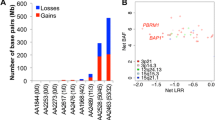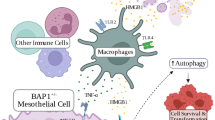Abstract
Human malignant pleural mesothelioma (MPM) is an aggressive cancer due to former asbestos exposure with little knowledge about prognostic factors of outcome and resistance to conventional therapy. BRCA1-associated protein 1 (BAP1) is a tumor suppressor gene that is frequently lost in MPM. Germline mutations of BAP1 predispose to several different tumors including malignant mesothelioma. Our study aimed to clarify if asbestos exposure has an influence on BAP1 expression and if BAP1 expression could be used as a prognostic factor of outcome. An immunohistochemical staining for BAP1 was performed on 123 MPM tissue samples and the expression levels have been correlated with asbestos exposure and overall survival time. BAP1 expression was not associated with asbestos exposure but we detected a significant effect of BAP1 expression on overall survival time - the higher the BAP1 expression (non-mutated BAP1), the shorter the overall survival. BAP1 mutation has been linked to non-asbestos induced familial mesotheliomas, which usually belong to the long survivor group and BAP1 is most probably functioning differently than in sporadic cases. Further investigations need to be performed to characterize the BAP1 mutations and to identify the BAP1 downstream targets in MPM.





Similar content being viewed by others
References
Tomasetti M, Amati M, Santarelli L, Alleva R, Neuzil J (2009) Malignant mesothelioma: biology, diagnosis and therapeutic approaches. Curr Mol Pharmacol 2(2):190–206
Paleari L, Rotolo N, Imperatori A, Puzone R, Sessa F, Franzi F, Meacci E, Camplese P, Cesario A, Paganuzzi M (2009) Osteopontin is not a specific marker in malignant pleural mesothelioma. Int J Biol Markers 24(2):112–117
Belli C, Fennell D, Giovannini M, Gaudino G, Mutti L (2009) Malignant pleural mesothelioma: current treatments and emerging drugs. Expert Opin Emerg Drugs 14(3):423–437. doi:10.1517/14728210903074563
Neragi-Miandoab S (2006) Multimodality approach in management of malignant pleural mesothelioma. Eur J Cardiothorac Surg 29(1):14–19. doi:10.1016/j.ejcts.2005.10.008
Treasure T, Sedrakyan A (2004) Pleural mesothelioma: little evidence, still time to do trials. Lancet 364(9440):1183–1185. doi:10.1016/s0140-6736(04)17108-0
Moore AJ, Parker RJ, Wiggins J (2008) Malignant mesothelioma. Orphanet J Rare Dis 3:34. doi:10.1186/1750-1172-3-34
Montjoy C, Parker J, Petsonk L, Luis T, Fallon K (2009) Mesothelioma review. W V Med J 105(3):13–16
Gordon GJ, Appasani K, Parcells JP, Mukhopadhyay NK, Jaklitsch MT, Richards WG, Sugarbaker DJ, Bueno R (2002) Inhibitor of apoptosis protein-1 promotes tumor cell survival in mesothelioma. Carcinogenesis 23(6):1017–1024
He B, You L, Uematsu K, Zang K, Xu Z, Lee AY, Costello JF, McCormick F, Jablons DM (2003) SOCS-3 is frequently silenced by hypermethylation and suppresses cell growth in human lung cancer. Proc Natl Acad Sci U S A 100(24):14133–14138. doi:10.1073/pnas.2232790100
Xia C, Xu Z, Yuan X, Uematsu K, You L, Li K, Li L, McCormick F, Jablons DM (2002) Induction of apoptosis in mesothelioma cells by antisurvivin oligonucleotides. Mol Cancer Ther 1(9):687–694
Ceresoli GL, Locati LD, Ferreri AJ, Cozzarini C, Passoni P, Melloni G, Zannini P, Bolognesi A, Villa E (2001) Therapeutic outcome according to histologic subtype in 121 patients with malignant pleural mesothelioma. Lung Cancer 34(2):279–287
Flores RM, Zakowski M, Venkatraman E, Krug L, Rosenzweig K, Dycoco J, Lee C, Yeoh C, Bains M, Rusch V (2007) Prognostic factors in the treatment of malignant pleural mesothelioma at a large tertiary referral center. J Thorac Oncol 2(10):957–965. doi:10.1097/JTO.0b013e31815608d9
Proietti L, Spicuzza L, Di Maria A, Polosa R, Sebastian Torres E, Asero V, Di Maria GU (2006) Non-occupational malignant pleural mesothelioma due to asbestos and non-asbestos fibres. Monaldi Arch Chest Dis 65(4):210–216
Testa JR, Cheung M, Pei J, Below JE, Tan Y, Sementino E, Cox NJ, Dogan AU, Pass HI, Trusa S, Hesdorffer M, Nasu M, Powers A, Rivera Z, Comertpay S, Tanji M, Gaudino G, Yang H, Carbone M (2011) Germline BAP1 mutations predispose to malignant mesothelioma. Nat Genet 43(10):1022–1025. doi:10.1038/ng.912
Jensen DE, Proctor M, Marquis ST, Gardner HP, Ha SI, Chodosh LA, Ishov AM, Tommerup N, Vissing H, Sekido Y, Minna J, Borodovsky A, Schultz DC, Wilkinson KD, Maul GG, Barlev N, Berger SL, Prendergast GC, Rauscher FJ 3rd (1998) BAP1: a novel ubiquitin hydrolase which binds to the BRCA1 RING finger and enhances BRCA1-mediated cell growth suppression. Oncogene 16(9):1097–1112
Jensen DE, Rauscher FJ 3rd (1999) BAP1, a candidate tumor suppressor protein that interacts with BRCA1. Ann N Y Acad Sci 886:191–194
Ventii KH, Devi NS, Friedrich KL, Chernova TA, Tighiouart M, Van Meir EG, Wilkinson KD (2008) BRCA1-associated protein-1 is a tumor suppressor that requires deubiquitinating activity and nuclear localization. Cancer Res 68(17):6953–6962. doi:10.1158/0008-5472.can-08-0365
Harbour JW, Onken MD, Roberson ED, Duan S, Cao L, Worley LA, Council ML, Matatall KA, Helms C, Bowcock AM (2010) Frequent mutation of BAP1 in metastasizing uveal melanomas. Science 330(6009):1410–1413. doi:10.1126/science.1194472
Wiesner T, Obenauf AC, Murali R, Fried I, Griewank KG, Ulz P, Windpassinger C, Wackernagel W, Loy S, Wolf I, Viale A, Lash AE, Pirun M, Socci ND, Rutten A, Palmedo G, Abramson D, Offit K, Ott A, Becker JC, Cerroni L, Kutzner H, Bastian BC, Speicher MR (2011) Germline mutations in BAP1 predispose to melanocytic tumors. Nat Genet 43(10):1018–1021. doi:10.1038/ng.910
Abdel-Rahman MH, Pilarski R, Cebulla CM, Massengill JB, Christopher BN, Boru G, Hovland P, Davidorf FH (2011) Germline BAP1 mutation predisposes to uveal melanoma, lung adenocarcinoma, meningioma, and other cancers. J Med Genet 48(12):856–859. doi:10.1136/jmedgenet-2011-100156
Carbone M, Korb Ferris L, Baumann F, Napolitano A, Lum CA, Flores EG, Gaudino G, Powers A, Bryant-Greenwood P, Krausz T, Hyjek E, Tate R, Friedberg J, Weigel T, Pass HI, Yang H (2012) BAP1 cancer syndrome: malignant mesothelioma, uveal and cutaneous melanoma, and MBAITs. J Transl Med 10(1):179. doi:10.1186/1479-5876-10-179
Wiesner T, Fried I, Ulz P, Stacher E, Popper H, Murali R, Kutzner H, Lax S, Smolle-Juttner F, Geigl JB, Speicher MR (2012) Toward an improved definition of the tumor spectrum associated with BAP1 germline mutations. J Clin Oncol. doi:10.1200/jco.2011.41.2965
Flores RM, Pass HI, Seshan VE, Dycoco J, Zakowski M, Carbone M, Bains MS, Rusch VW (2008) Extrapleural pneumonectomy versus pleurectomy/decortication in the surgical management of malignant pleural mesothelioma: results in 663 patients. J Thorac Cardiovasc Surg 135(3):620–626. doi:10.1016/j.jtcvs.2007.10.054, 626 e621-623
Flores RM (2009) Surgical options in malignant pleural mesothelioma: extrapleural pneumonectomy or pleurectomy/decortication. Semin Thorac Cardiovasc Surg 21(2):149–153. doi:10.1053/j.semtcvs.2009.06.008
Bott M, Brevet M, Taylor BS, Shimizu S, Ito T, Wang L, Creaney J, Lake RA, Zakowski MF, Reva B, Sander C, Delsite R, Powell S, Zhou Q, Shen R, Olshen A, Rusch V, Ladanyi M (2011) The nuclear deubiquitinase BAP1 is commonly inactivated by somatic mutations and 3p21.1 losses in malignant pleural mesothelioma. Nat Genet 43(7):668–672. doi:10.1038/ng.855
Ladanyi M, Zauderer MG, Krug LM, Ito T, McMillan R, Bott M, Giancotti FG (2012) New strategies in pleural mesothelioma: BAP1 and NF2 as novel targets for therapeutic development and risk assessment. Clin Cancer Res. doi:10.1158/1078-0432.ccr-11-2375
Yoshikawa Y, Sato A, Tsujimura T, Emi M, Morinaga T, Fukuoka K, Yamada S, Murakami A, Kondo N, Matsumoto S, Okumura Y, Tanaka F, Hasegawa S, Nakano T, Hashimoto-Tamaoki T (2012) Frequent inactivation of the BAP1 gene in epithelioid-type malignant mesothelioma. Cancer Sci 103(5):868–874. doi:10.1111/j.1349-7006.2012.02223.x
Kittler R, Pelletier L, Heninger AK, Slabicki M, Theis M, Miroslaw L, Poser I, Lawo S, Grabner H, Kozak K, Wagner J, Surendranath V, Richter C, Bowen W, Jackson AL, Habermann B, Hyman AA, Buchholz F (2007) Genome-scale RNAi profiling of cell division in human tissue culture cells. Nat Cell Biol 9(12):1401–1412. doi:10.1038/ncb1659
Mallery DL, Vandenberg CJ, Hiom K (2002) Activation of the E3 ligase function of the BRCA1/BARD1 complex by polyubiquitin chains. EMBO J 21(24):6755–6762
Schlabach MR, Luo J, Solimini NL, Hu G, Xu Q, Li MZ, Zhao Z, Smogorzewska A, Sowa ME, Ang XL, Westbrook TF, Liang AC, Chang K, Hackett JA, Harper JW, Hannon GJ, Elledge SJ (2008) Cancer proliferation gene discovery through functional genomics. Science 319(5863):620–624. doi:10.1126/science.1149200
Illei PB, Rusch VW, Zakowski MF, Ladanyi M (2003) Homozygous deletion of CDKN2A and codeletion of the methylthioadenosine phosphorylase gene in the majority of pleural mesotheliomas. Clin Cancer Res 9(6):2108–2113
Dacic S, Kothmaier H, Land S, Shuai Y, Halbwedl I, Morbini P, Murer B, Comin C, Galateau-Salle F, Demirag F, Zeren H, Attanoos R, Gibbs A, Cagle P, Popper H (2008) Prognostic significance of p16/cdkn2a loss in pleural malignant mesotheliomas. Virchows Arch 453(6):627–635. doi:10.1007/s00428-008-0689-3
Thurneysen C, Opitz I, Kurtz S, Weder W, Stahel RA, Felley-Bosco E (2009) Functional inactivation of NF2/merlin in human mesothelioma. Lung Cancer 64(2):140–147. doi:10.1016/j.lungcan.2008.08.014
Machida YJ, Machida Y, Vashisht AA, Wohlschlegel JA, Dutta A (2009) The deubiquitinating enzyme BAP1 regulates cell growth via interaction with HCF-1. J Biol Chem 284(49):34179–34188. doi:10.1074/jbc.M109.046755
Misaghi S, Ottosen S, Izrael-Tomasevic A, Arnott D, Lamkanfi M, Lee J, Liu J, O’Rourke K, Dixit VM, Wilson AC (2009) Association of C-terminal ubiquitin hydrolase BRCA1-associated protein 1 with cell cycle regulator host cell factor 1. Mol Cell Biol 29(8):2181–2192. doi:10.1128/mcb.01517-08
Sowa ME, Bennett EJ, Gygi SP, Harper JW (2009) Defining the human deubiquitinating enzyme interaction landscape. Cell 138(2):389–403. doi:10.1016/j.cell.2009.04.042
Acknowledgments
The study was partly supported by an unrestricted grant from Pfizer Austria.
We gratefully thank Hildegard Gleixner, Margit Gogg-Kamerer, Elisabeth Grygar and Mohammed Al-Effah, Institute of Pathology, Medical University of Graz, for excellent technical assistance.
Author information
Authors and Affiliations
Corresponding author
Additional information
Lisa Arzt and Franz Quehenberger contributed equally to the study.
Rights and permissions
About this article
Cite this article
Arzt, L., Quehenberger, F., Halbwedl, I. et al. BAP1 Protein is a Progression Factor in Malignant Pleural Mesothelioma. Pathol. Oncol. Res. 20, 145–151 (2014). https://doi.org/10.1007/s12253-013-9677-2
Received:
Accepted:
Published:
Issue Date:
DOI: https://doi.org/10.1007/s12253-013-9677-2




